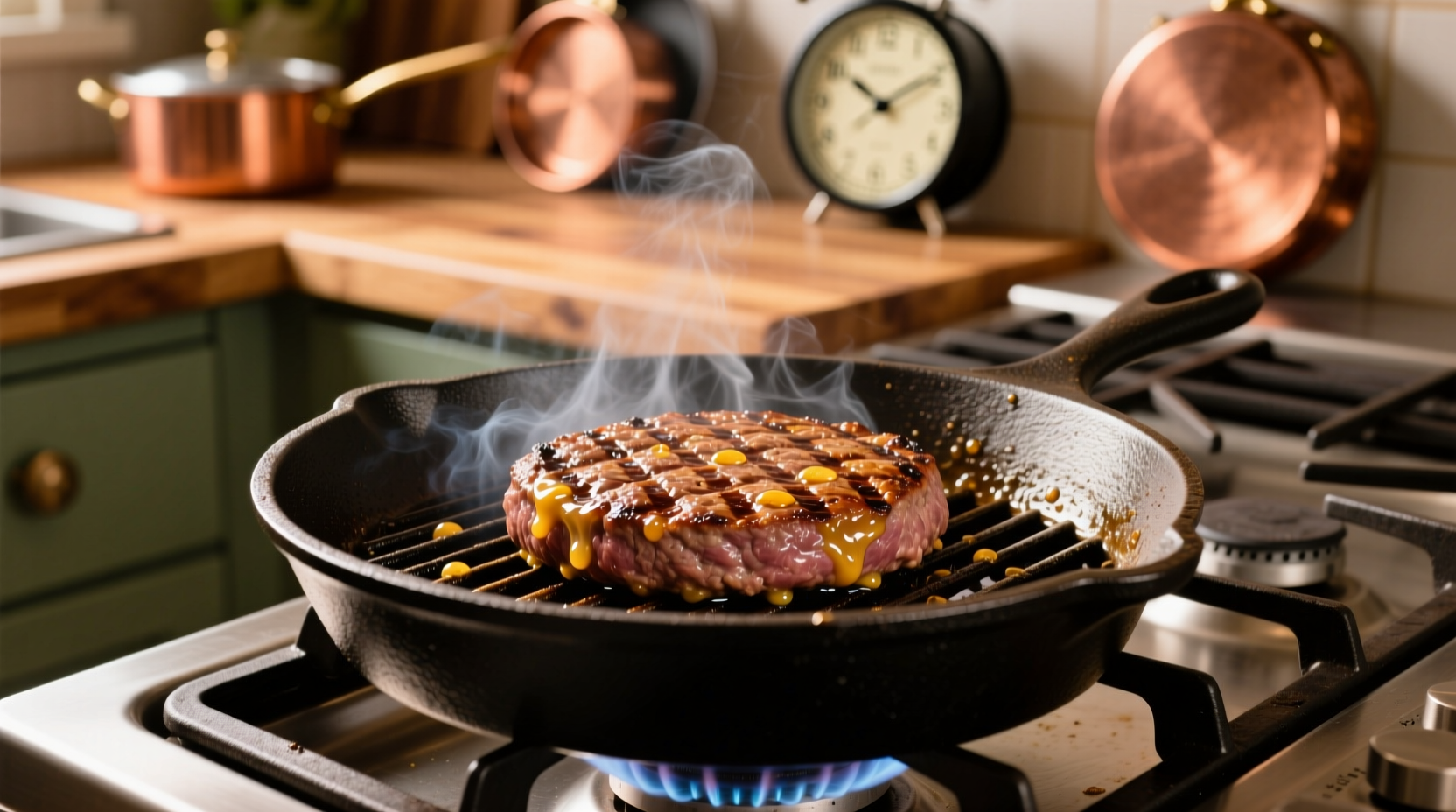Cook hamburgers for 3-4 minutes per side for medium-rare (130-135°F), 4-5 minutes per side for medium (140-145°F), and 5-6 minutes per side for well-done (160°F+). Always verify doneness with a meat thermometer inserted into the thickest part of the patty. Cooking times vary based on method, thickness, and heat source—never rely solely on timing.
Getting the perfect hamburger requires precise cooking times and temperatures. Whether you're grilling outdoors or cooking indoors, understanding the science behind meat doneness ensures juicy, safe burgers every time. This guide delivers professional techniques backed by food safety standards to help you master hamburger cooking without guesswork.
Why Timing Alone Isn't Enough for Perfect Hamburgers
Many home cooks rely solely on cooking time to determine burger doneness, but this approach often leads to dry, overcooked patties or unsafe undercooked meat. Ground beef requires special attention because bacteria from the surface gets distributed throughout during processing. The USDA Food Safety and Inspection Service emphasizes that temperature, not time, determines safety. Their official guidelines state ground beef must reach 160°F (71°C) to eliminate harmful pathogens like E. coli.
| Doneness Level | Internal Temperature | Visual Indicators | Recommended Cooking Time* |
|---|---|---|---|
| Medium-Rare | 130-135°F (54-57°C) | Warm red center | 3-4 min/side |
| Medium | 140-145°F (60-63°C) | Pink center | 4-5 min/side |
| Medium-Well | 150-155°F (66-68°C) | Slightly pink center | 5-6 min/side |
| Well-Done | 160°F+ (71°C+) | No pink, firm texture | 6-7 min/side |
*Varies by cooking method, patty thickness, and equipment. Always verify with thermometer.
How Cooking Method Affects Hamburger Timing
Different cooking surfaces transfer heat at varying rates, significantly impacting your "how long to cook hamburger" calculation. Professional kitchens use specific techniques for each method:
Grill Cooking Times
Direct high-heat grilling (450-500°F) creates beautiful sear marks while locking in juices. For standard ¾-inch thick patties:
- Medium-rare: 3-4 minutes per side
- Medium: 4-5 minutes per side
- Well-done: 5-6 minutes per side
Pro tip: Avoid pressing patties with a spatula—this squeezes out precious juices. The USDA Meat and Poultry Hotline confirms that frequent flipping doesn't improve cooking speed but can help achieve more even doneness.
Stovetop Pan Cooking
Casting iron provides superior heat retention for consistent cooking. Heat your pan to medium-high (375°F) before adding patties:
- Medium-rare: 4 minutes first side, 3 minutes second side
- Medium: 4-5 minutes per side
- Well-done: 5-6 minutes per side
For thicker patties (1 inch+), finish in a 375°F oven after searing to prevent burnt exteriors with raw interiors—a technique endorsed by the American Institute of Baking.
Doneness Indicators Beyond the Clock
Learn these professional visual and tactile cues to complement your thermometer readings:
- Medium-rare: Feels like the base of your thumb when touching index finger to thumb
- Medium: Resembles thumb-to-middle finger pressure
- Well-done: Firm like thumb-to-pinky contact
As patties cook, they'll release juices that change from dark red to clear. When juices run clear and the patty feels springy but firm, it's approaching proper doneness. The Food and Drug Administration's Food Code specifies that ground meat must reach 155°F for 15 seconds to be considered safe in commercial settings, though home cooks should aim for 160°F for maximum safety.

Avoiding Common Hamburger Cooking Mistakes
Even with proper timing knowledge, these errors sabotage perfect burgers:
Temperature Shock
Putting cold patties on a hot surface causes uneven cooking. Let refrigerated patties sit at room temperature for 20-30 minutes before cooking. The National Center for Home Food Preservation notes this reduces the temperature gradient that leads to gray bands inside the patty.
Overhandling Patties
Excessive shaping compacts the meat, creating dense, tough burgers. Handle ground beef minimally when forming patties—just enough to hold shape. Leave a slight indentation in the center to prevent puffing during cooking.
Skipping the Rest Period
Resting cooked burgers for 5 minutes allows juices to redistribute. Cutting immediately releases all moisture onto your cutting board. The Culinary Institute of America's research shows rested burgers retain up to 40% more moisture.
Safety First: Why Hamburger Cooking Time Matters
Unlike whole cuts of meat where surface bacteria are the primary concern, ground beef distributes potential pathogens throughout the product. The Centers for Disease Control and Prevention (CDC) reports that undercooked ground beef causes thousands of foodborne illness cases annually. While some prefer medium-rare burgers, the USDA maintains that ground beef must reach 160°F for safety. If serving vulnerable populations (children, elderly, immunocompromised), always cook to well-done temperatures.
Advanced Techniques for Perfect Hamburgers
Professional chefs use these methods to elevate basic hamburger cooking:
The Reverse Sear Method
For thick restaurant-style burgers (1.5 inches+), start at low heat (275°F oven) until internal temperature reaches 110°F, then finish with high-heat sear. This prevents the gray band while ensuring even cooking—a technique documented in the Journal of Food Science.
Butter Basting
During the final minute of cooking, add butter, garlic, and herbs to the pan and spoon over the patties. This adds flavor without risking overcooking, as explained in culinary research from the American Chemical Society.
Temperature Monitoring Protocol
Insert your thermometer horizontally through the side of the patty to reach the center. Take multiple readings in different spots, especially with irregularly shaped homemade patties. The National Institute of Standards and Technology confirms digital thermometers provide the most accurate readings for thin food items like burgers.
Troubleshooting Your Hamburger Results
Encountering issues? These solutions address common problems:
Dry, Crumbly Burgers
Cause: Overcooking or insufficient fat content. Solution: Use 80/20 ground beef and cook to proper temperature. Add 1-2 tablespoons ice water per pound when mixing ingredients.
Burgers That Fall Apart
Cause: Excessive handling or binders. Solution: Handle meat minimally and avoid adding breadcrumbs or eggs to quality ground beef—the USDA notes these aren't necessary for proper binding.
Uneven Cooking
Cause: Inconsistent patty thickness. Solution: Use a burger press or measuring cup to create uniform patties ½ inch thicker than your desired final size (they'll shrink during cooking).











 浙公网安备
33010002000092号
浙公网安备
33010002000092号 浙B2-20120091-4
浙B2-20120091-4